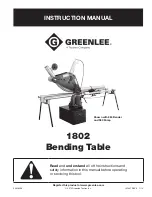
Page 3
Maintain tools with care. Keep cutting tools sharp
and clean.
Properly maintained tools, with sharp
cutting edges are less likely to bind and are easier to
control. Any alteration or modification is a misuse and
may result in a dangerous condition.
Check for misalignment or binding of moving parts,
breakage of parts, and any other condition that may
affect the tools operation. If damaged, have the tool
serviced before using.
Many accidents are caused by
poorly maintained tools. Develop a periodic
maintenance schedule for your tool.
Use only accessories that are recommended by the
manufacturer for your model.
Accessories that may
be suitable for one tool, may become hazardous when
used on another tool.
Service
Tool service must be performed only by qualified
repair personnel.
Service or maintenance performed
by unqualified personnel could result in a risk of
injury. For example: internal wires may be misplaced
or pinched, safety guard return springs may be
improperly mounted.
When ser vicing a tool, use only identical
replacement parts. Follow instructions in the
Maintenance section of this manual.
Use of
unauthorized parts or failure to follow Maintenance
Instructions may create a risk of electric shock or
injury. Certain cleaning agents such as gasoline,
carbon tetrachloride, ammonia, etc. may damage
plastic parts.
Safety Rules for Rotary Tools
Accessories must be rated for at least the speed
recommended on the tool warning label.
Wheels
and other accessories running over rated speed can
fly apart and cause injury.
Hold tool by insulated gripping surfaces when
performing an operation where the cutting tool may
contact hidden wiring or its own cord.
Contact with
a "live" wire will make exposed metal parts of the tool
"live" and shock the operator. If cutting into existing
walls or other blind areas where electrical wiring may
exist is unavoidable, disconnect all fuses or circuit
breakers feeding this worksite.
Do not operate the flexible shaft with a sharp bend.
Over bending the shaft can generate excessive heat
on the jacket or hand piece. The recommended
minimum is 6" radius.
Always disconnect the power cord from the power
source before making any adjustments or attaching
any accessories.
You may unexpectedly cause the
tool to start leading to serious personal injury.
Be aware of the switch location, when placing the
tool down or when picking the tool up.
You may
accidentally activate the switch.
Always hold the hand piece firmly in your hands
during the start-up.
The reaction torque of the motor,
as it accelerates to full speed, can cause the shaft to
twist.
Always wear safety goggles and dust mask. Use
only in well ventilated area.
Using personal safety
devices and working in safe environment reduces risk
of injury.
After changing the bits or making any adjustments,
make sure the collet nut and any other adjustment
devices are securely tightened.
Loose adjustment
device can unexpectedly shift, causing loss of control,
loose rotating components will be violently thrown.
Do not reach in the area of the spinning bit.
The
proximity of the spinning bit to your hand may not
always be obvious.
Allow brushes to run at operating speed for at least
one minute before using wheel. During this time no
one is to stand in front or in line with the brush.
Loose bristles or wires will be discharged during the
run-in time.
Wire and bristle brushes must never be operated at
speeds greater than 15,000/min. Direct the
discharge of the spinning wire brush away from
you.
Small particles and tiny wire fragments may be
discharged at high velocity during the “cleaning”
action with these brushes and may become imbedded
in your skin. Bristles or wires will be discharged from
the brush at high speeds.
Wear protective gloves and face shield with wire or
bristle brushes. Apply wire or bristle brushes lightly
to the work as only the tips of the wire/bristles do
the work.
“Heavy” pressure on bristles will cause the
wire or bristle to become overstressed, resulting in a
wiping action and will cause the bristles/wire to be
discharged.
Carefully handle both the tool and individual
grinding wheels to avoid chipping or cracking.
Install a new wheel if tool is dropped while
Summary of Contents for 398
Page 24: ...Page 24 ...
Page 48: ...Page 48 ...




































